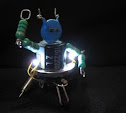Lightweight DTLS reverse proxy server based on tinydtls and libev.
https://github.com/julznc/dtlsproxy
Wednesday, September 13, 2017
Saturday, May 6, 2017
ATtiny IR Remote
ATtiny2313 Infrared Sender
parts:




avr-gcc (main.c) code:
References:
ESP8266 IR Remote
z3t0/Arduino-IRremote
ATtiny Low Power
parts:
- ATtiny2313 @4MHz (internal oscillator)
- IR LED (series with 220-ohm resistor)
- Tact switches
- 3.7V lithium ion battery & Capacitor




avr-gcc (main.c) code:
References:
ESP8266 IR Remote
z3t0/Arduino-IRremote
ATtiny Low Power
Friday, May 5, 2017
ESP8266 IR Remote
Control your appliances (e.g. TV and AV systems) via WiFi+IR.

Arduino code:
References:
markszabo/IRremoteESP8266
Sony IR codes
Sony SIRC protocol

Arduino code:
References:
markszabo/IRremoteESP8266
Sony IR codes
Sony SIRC protocol
Sunday, January 29, 2017
WiFi RGB Matrix
Here's a DIY flexible 36x8 RGB-LED-matrix controlled via WiFi connection using an ESP8266 module.
Arduino Code: julznc/wifi_rgb_matrix
Assembly:
References:
NeoPixelBus - for interfacing WS2812 LEDs to ESP8266 controller
Adafruit-GFX-Library - with font library for displaying texts
LED Matrix Studio - for creating bitmap images
Arduino Code: julznc/wifi_rgb_matrix
Assembly:
 |  |  |
 |  |  |
 |  |  |
References:
NeoPixelBus - for interfacing WS2812 LEDs to ESP8266 controller
Adafruit-GFX-Library - with font library for displaying texts
LED Matrix Studio - for creating bitmap images
Subscribe to:
Comments (Atom)

